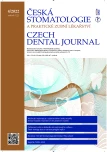DENTAL IMPLANT TREATMENT IN THE POSTERIOR MAXILLA
Authors:
J. Bublík 1,2; P. Michl 2
Authors‘ workplace:
Restorative Driven Implants Institute, Wausau, Wisconsin, USA
1; Klinika ústní, čelistní a obličejové chirurgie, Lékařská fakulta Univerzity Palackého v Olomouci, a Fakultní nemocnice Olomouc
2
Published in:
Česká stomatologie / Praktické zubní lékařství, ročník 122, 2022, 4, s. 105-112
Category:
Practical Report
doi:
https://doi.org/10.51479/cspzl.2022.011
Overview
Introduction and aim: Dental implant treatment in the posterior maxilla is often complicated by the poor healing of the alveolar process and by the pneumatization of the maxillary sinus. The authors are explaining the Cologne Classification of the Alveolar Ridge Defects (CCARD) with special emphasis on the maxillary sinus area and listing the main fators influencing process of selection of dental implant treatment. The aim of this article is to demonstrate, using case reports, four types of treatment.
Results and conclusions: There are four types of treatment implant surgeon must choose from while considering treatment in posterior maxilla. Current literature does not give a guidance as to which treatment method to use. Transalveolar sinus lift has a good clinical outcome regardless of presence or absence of grafting material. Short implants with a long clinical crown are good alternative to treatment at times where Schneiderian membrane manipulation is not advised.
Keywords:
posterior maxilla – short implants – sinus lift – transalveolar sinus lift – CCARD
Sources
- Conrad HJ, Jung J, Barczak M, Basu S, Seong WJ. Retrospective cohort study of the predictors of implant failure in the posterior maxilla. Int J Oral Maxillofac Implants. 2011; 26(1): 154–162.
- Huynh-Ba G, Friedberg JR, Vogiatzi D, Ioannidou E. Implant failure predictors in the posterior maxilla: a retrospective study of 273 consecutive implants. J Periodontol. 2008; 79(12): 2256-61. doi: 10.1902/ jop.2008.070602
- Cologne Classification of Alveolar Ridge Defects (CCARD) 8th European Consensus Conference of BDIZ EDI, 2013 February, European Association of Dental Implantologists.
- Mish CE. Contemporary implant dentistry. 3th ed. Mosby: Elsevier; 2008, 134–140.
- Norton MR. The influence of low insertion torque on primary stability, implant survival, and maintenance of marginal bone levels: a closed-cohort prospective study. Int J Oral Maxillofac Implants. 2017; 32(4): 849-857. doi: 10.11607/jomi.5889
- Fan T, Li Y, Deng WW, Wu T, Zhang W. Short implants (5 to 8 mm) versus longer implants (>8 mm) with sinus lifting in atrophic posterior maxilla: a meta-analysis of RCTs. Clin Implant Dent Relat Res. 2017; 19(1): 207–215. doi: 10.1111/cid.12432.
- Chaware SH, Thakare V, Chaudhary R, Jankar A, Thakkar S, Borse S. The rehabilitation of posterior atrophic maxilla by using the graftless option of short implant versus conventional long implant with sinus graft: A systematic review and meta-analysis of randomized controlled clinical trial. J Indian Prosthodont Soc. 2021; 21(1): 28–44. doi: 10.4103/jips.jips_400_20
- Mish CE. Contemporary implant dentistry. 3th ed. Mosby, Elsevier; 2008, 68.
- Pellizzer EP, Marcela de Luna Gomes J, Araújo Lemos CA, Minatel L, Justino de Oliveira Limírio JP, Dantas de Moraes SL. The influence of crown-to-implant ratio in single crowns on clinical outcomes: A systematic review and meta-analysis. J Prosthet Dent. 2021; 126(4): 497–502. doi: 10.1016/j.prosdent.2020.06.010
- Tang Y, Yu H, Wang J, Gao M, Qiu L. Influence of crown-to-implant ratio and different prosthetic designs on the clinical conditions of short implants in posterior regions: A 4-year retrospective clinical and radiographic study. Clin Implant Dent Relat Res. 2020; 22(1): 119–127. doi: 10.1111/ cid.12881
- Ravidà A, Barootchi S, Alkanderi A, Tavelli L, Suárez-López Del Amo F. The effect of crown-to-implant ratio on the clinical outcomes of dental implants: a systematic review. Int J Oral Maxillofac Implants. 2019; 34(5): 1121–1131. doi: 10.11607/jomi.7355
- Zhou W, Han C, Li D, Li Y, Song Y, Zhao Y. Endodontic treatment of teeth induces retrograde peri-implantitis. Clin Oral Implants Res. 2009; 20(12): 1326–1332. doi: 10.1111/j.1600-0501.2009.01752.x
- Moreno Vazquez JC, Gonzalez de Rivera AS, Gil HS, Mifsut RS. Complication rate in 200 consecutive sinus lift procedures: guidelines for prevention and treatment. J Oral Maxillofac Surg. 2014; 72(5): 892–901. doi: 10.1016/j.joms.2013.11.023
- Patel NA, Ferguson BJ. Odontogenic sinusitis: an ancient but under-appreciated cause of maxillary sinusitis. Curr Opin Otolaryngol Head Neck Surg. 2012; 20(1): 24–8. doi: 10.1097/ MOO.0b013e32834e62ed
- Elsayyad AA, Osman RB. Osseodensification in implant dentistry: A critical review of the literature. Implant Dent. 2019; 28(3): 306–312. doi: 10.1097/ ID.0000000000000884
Labels
Maxillofacial surgery Orthodontics Dental medicineArticle was published in
Czech Dental Journal

2022 Issue 4
Most read in this issue
- POŠKOZENÍ ZUBŮ V DŮSLEDKU MIMOJÍCNOVÉHO REFLUXU
- DENTAL IMPLANT TREATMENT IN THE POSTERIOR MAXILLA
- DOC. MUDR. OTAKAR BRÁZDA, CSC., OSLAVIL VÝZNAMNÉ ŽIVOTNÍ JUBILEUM
- 100 LET STOMATOLOGICKÉ KLINIKY (1922–2022)
